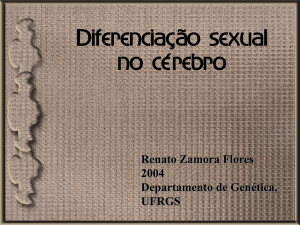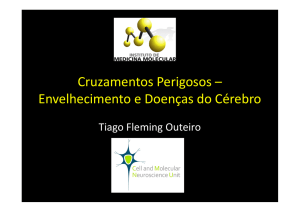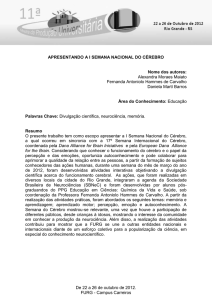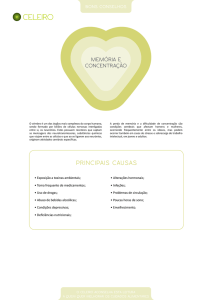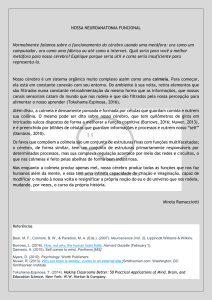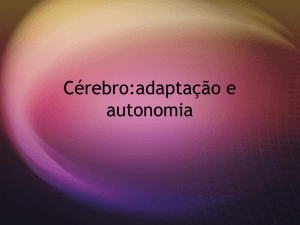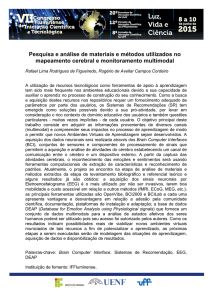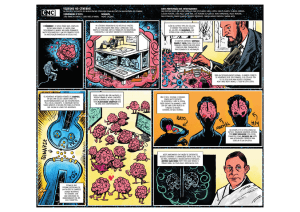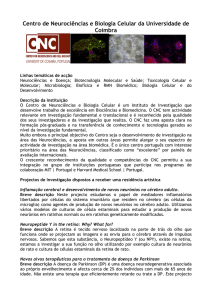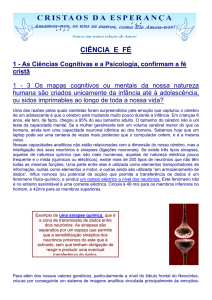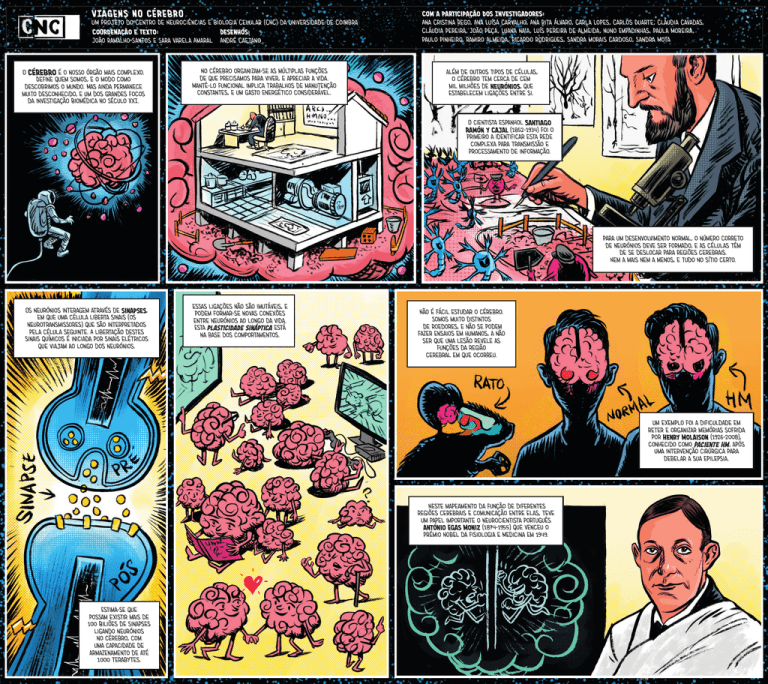
VIAGENS NO CÉREBRO
UM Projeto do Centro De Neurociências e Biologia Celular (CNC) da Universidade de Coimbra
Coordenação e Texto:
João Ramalho-Santos e Sara Varela Amaral
O cérebro é o nosso órgão mais complexo.
Define quem somos, e o modo como
descobrimos o mundo. Mas ainda permanece
muito desconhecido, e um dos grandes focos
da investigação Biomédica no Século XXI.
Desenhos:
André Caetano
No cérebro organizam-se as múltiplas funções
de que precisamos para viver, e apreciar a vida.
Mantê-lo funcional implica trabalhos de manutenção
constantes, e um gasto energético considerável.
Com a participação dos Investigadores:
Ana Cristina Rego, Ana Luísa Carvalho, Ana Rita Álvaro, Carla Lopes, Carlos Duarte, Cláudia Cavadas,
Cláudia Pereira, João Peça, Luana Naia, Luís Pereira de Almeida, Nuno Empadinhas, Paula Moreira,
Paulo Pinheiro, Ramiro Almeida, Ricardo Rodrigues, Sandra morais Cardoso, Sandra Mota
além de outros tipos de células,
o cérebro tem cerca de cem
mil milhões de neurónios, que
estabelecem ligações entre si.
O cientista espanhol Santiago
Ramón y Cajal (1852-1934) foi o
primeiro a identificar esta rede
complexa para transmissão e
processamento de informação.
Para um desenvolvimento normal, o número correto
de neurónios deve ser formado, e as células têm
de se deslocar para regiões cerebrais.
Nem a mais nem a menos, e tudo no sítio certo.
Os neurónios interagem através de sinapses,
em que uma célula liberta sinais (os
neurotransmissores) que são interpretados
pela célula seguinte. A libertação destes
sinais químicos é iniciada por sinais elétricos
que viajam ao longo dos neurónios.
essas ligações não são imutáveis, e
podem formar-se novas conexões
entre neurónios ao longo da vida.
Esta plasticidade sináptica está
na base dos comportamentos.
Não é fácil estudar o cérebro.
Somos muito distintos
de roedores, e não se podem
fazer ensaios em humanos, a não
ser que uma lesão revele as
funções da região
cerebral em que ocorreu.
Um exemplo foi a dificuldade em
reter e organizar memórias sofrida
por Henry Molaison (1926-2008),
conhecido como Paciente HM, após
uma intervenção cirúrgica Para
debelar a sua epilepsia.
Neste mapeamento da função de diferentes
regiões cerebrais e comunicação entre elas, teve
um papel importante o neurocientista português
António Egas Moniz (1874-1955) que venceu o
prémio Nobel da Fisiologia e Medicina em 1949.
Estima-se que
possam existir mais de
100 Biliões de sinapses
ligando neurónios
no cérebro, com
uma capacidade de
armazenamento de até
1000 terabytes.
Uma das áreas mais fascinantes de investigação
em Neurociências diz respeito aos circuitos neuronais
envolvidos em comportamentos sociais complexos,
cruzando perspetivas interdisciplinares.
hábitos alimentares, exercício
(físico e mental), e um sono regular
são fundamentais para manter uma
boa atividade cerebral.
Uma comunicação comprometida
entre os neurónios acontece nas
disfunções neuro-psiquiátricas
como Autismo, Esquizofrenia
ou Hiperatividade…
A investigação de fronteira
nesta área inclui também uma
relação entre o intestino e o
cérebro, em que a proporção
entre bactérias patogénicas
e benéficas pode afetar a
atividade cerebral, através
do nervo vago.
As doenças Neurodegenerativas
afetam pacientes de maneiras muito
distintas. Daí a importância da investigação
em Biomarcadores (substâncias
detetadas no sangue, saliva, urina,
fluidocefalorraquidiano) que possam prever
o aparecimento e progressão de doenças,
bem como monitorizar a terapêutica.
É o que sucede nas doenças
de Parkinson, Alzheimer,
Huntington ou Machado-Joseph,
muitas vezes com uma forte
componente genética familiar.
E até influenciar
a progressão de
patologias como a
doença de Parkinson.
Impedir a morte de neurónios,
controlar a formação de agregados,
ou repor a função mitocondrial são
algumas das estratégias terapêuticas
em doenças do cérebro, que
também incluem o controlo de
processos inflamatórios.
ou nas doenças neurodegenerativas
como Alzheimer, Parkinson,
Huntington ou Machado-Joseph,
em que a causa principal das falhas
na comunicação é a própria
morte dos neurónios.
Mas tudo que ajude a
exercitar este órgão
pode ser útil.
Um sistema de controlo de
qualidade é essencial no cérebro. A
formação e deposição de agregados
proteicos nos neurónios está
relacionada com morte celular, e
com problemas cognitivos e motores.
Quando há uma
componente genética pode vir
a ser possível aplicar terapia
génica, em que se introduz uma
cópia normal para substituir
um gene alterado ou se
limita a sua atividade.
Outro ponto sensível é a energia
disponível para a atividade cerebral,
produzida por mitocôndrias, as
“centrais energéticas da célula”.
Danos nestas estruturas
também estão envolvidos em
neurodegeneração, algo que
pode ser agravado por
patologias como a Diabetes.
A investigação em Neurociências
promete revelar muito mais
sobre o cérebro nas próximas décadas,
proporcionando viagens inéditas a
novas gerações de investigadores .
Mas é bom recordar que
o potencial imenso deste
órgão está presente em
cada um de nós. E deve
ajudar-nos diariamente a
encontrar os equilíbrios
para um futuro melhor.
BRAIN VOYAGES
WITH THE PARTICIPATION OF THE RESEARCHERS:
A project developed by the Center for Neuroscience and Cell Biology (CNC) of the University of Coimbra, Portugal Ana Cristina Rego, Ana Luísa Carvalho, Ana Rita Álvaro, Carla Lopes, Carlos Duarte, Cláudia Cavadas,
Cláudia Pereira, João Peça, Luana Naia, Luís Pereira de Almeida, Nuno Empadinhas, Paula Moreira,
CoordINATION AND Text:
ART:
Paulo Pinheiro, Ramiro Almeida, Ricardo Rodrigues, Sandra morais Cardoso, Sandra Mota
João Ramalho-Santos e Sara Varela Amaral
André Caetano
The brain is our most complex organ. It
defines who we are and how we discover the
world. But it remains largely unknown, and
is one of the great challenges in Biomedical
research for the 21rst Century.
The many functions that we rely on to live, and
appreciate life, are organized by the brain. Keeping
it functional implies constant maintenance, and
consumes large amounts of energy..
Besides other cell types, the brain is
made up by around one hundred billion
interconnected neurons.
The Spanish Researcher Santiago
Ramón y Cajal (1852-1934)
was the first to identify this
complex network that transmits
and processs information.
For normal development, a precise number
of neurons must be formed, which then
migrate to distinct brain regions.
No more, no less; and all in the right place.
Neurons connect each other via synapses,
with one cell releasing chemical
signals called neurotransmitters that
are interpreted by the following cell.
Neurotransmitter release is controlled by
electric currents that travel along neurons.
These connections between
neuros are not totally
fixed, and can be rearranged
throughout life. This synaptic
plasticity underlies different
types of behaviors.
Studying the brain is not easy. We
are very different from rodents,
and human experimentation is
impossible, unless a lesion can
suggest the function of the
brain region where it occurred.
One well-known example is the case
of Henry Molaison (1926-2008),
known as Patient HM. After a surgery
performed to control his epilepsy,
he lost the ability to correctly
retain and organize memories.
The Portuguese Neuroscientist António Egas
Moniz (1874-1955) had an important role in
uncovering the roles of different brain regions
and how they interact. He was awarded the Nobel
Prize in Physiology and Medicine in 1949.
A rough estimate
suggests that there
may be more than 100
trillion synapses in the
brain, corresponding to
about 1000 terabytes of
storage capacity.
It is possible that there is
some plasticity in the brain,
that some regions may replace
the function of others.
Eating habits, exercise (both
physical and intellectual), and
regular sleep are important to
maintain the brain active.
Autism, Schizophrenia,
Hyperactivity and other Neuro-
Psychiatric disorders result for
compromised connections
between neurons.
One of the most fascinating and interdisciplinary (and
controversial) areas of Brain Research involves neuronal
circuits, responsible for complex social behaviors.
Cutting-edge research in
this field also includes the
gut-brain axis, and how the
proportions of pathogenic and
helpful bacteria in the gut
may influence brain activity,
via the vagus nerve.
Neurodegenerative disorders
may affect different patients in
very different ways. Biomarkers
(substances detected in blood, urine
saliva, cerebrospinal fluid) may help
predict disease progression,
or monitor the success of
therapeutic strategies.
This takes place in Alzheimer’s,
Parkinson’s, Huntington’s or
Machado-Joseph Disease, often
with a strong genetic component
that runs in families.
And even influence
the progression of
conditions such as
Parkinson’s disease.
Preventing neuron death, removing
protein aggregates, boosting
mitochondrial function, or controlling
inflammation are some of the therapeutic
strategies for brain disorders
This also happens in
Neurodegenerative disorders, such
as Alzheimer’s, Parkinson’s,
Huntington’s or Machado-Joseph
Disease, where the main reason for
communication breakdown
is neuron death.
But everything that
helps exercise this
organ can be useful.
Quality control is essential
for proper brain function. The
formation and deposit of protein
aggregates in neurons is
correlated with cell death, and
with cognitionand motor problems.
When a genetic component is
involved gene therapy may also be
possible, by replacing an altered
gene, or reducing its activity.
Another important issue is the
energy available for brain activity,
produced by mitochondria, the
“power plants” of cells.
Mitochondrial damage is also
involved in neurodegeneration,
and this problem can be worsened
by conditions such as Diabetes.
Research in Neurosciences promises to
uncover much more on the brain the
coming decades, thus allowing new
generations of researchers to embark
on the voyages of their lives.
But we must also remember
that the enormous
potential of this organ is
present in each and every
one of us. It should be
unleashed daily, to help us
find the right solutions
for a better future.

